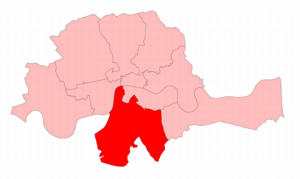Lambeth (UK Parliament constituency) facts for kids
Quick facts for kids {{{Name}}}[[{{{Type}}} constituency]] |
|
|---|---|
| [[Image:{{{Map1}}}Constituency.svg|120px|]] [[Image:England{{{Map2}}}.svg|120px|]] |
|
| {{{Name}}} shown within [[{{{Entity}}}]], and {{{Entity}}} shown within England | |
| Created: | {{{Year}}} |
| MP: | {{{MP}}} |
| Party: | {{{Party}}} |
| Type: | House of Commons |
| County: | [[{{{County}}}]] |
| EP constituency: | [[{{{EP}}} (European Parliament constituency)|{{{EP}}}]] |
Lambeth was a special area in the United Kingdom that had its own representatives in the UK Parliament. Think of it like a school district, but for voting for national leaders! This area existed from 1832 to 1885. It covered parts of what we now know as the London Borough of Lambeth and the southern and central parts of the London Borough of Southwark.
The people living in Lambeth got to choose two Members of Parliament (MPs). These MPs would then represent Lambeth in the UK Parliament. They were chosen using a system where the candidates with the most votes won, similar to how we might pick a team captain.
How Lambeth's Voting Area Changed
The Lambeth voting area was created because of a big change in how people voted, called the Great Reform Act in 1832. This law helped more people vote and created new areas like Lambeth.
Later, in 1885, another law called the Redistribution of Seats Act 1885 changed things again. Lambeth was split into eight smaller voting areas. These new areas included places like Camberwell North, Camberwell Peckham, Lambeth Brixton, and Lambeth Kennington. This meant that instead of two MPs for a large Lambeth, there would be eight MPs for these smaller, new areas.
Understanding Lambeth's Boundaries
When Lambeth was first planned, it was going to be even bigger! It was meant to include all of Dulwich and Brixton, and maybe even two more areas to the east. However, special officials were in charge of deciding the exact borders for London's new voting areas. They wanted to make sure that the seven new "metropolitan" areas in London had a similar number of voters and people.
Because of this, some areas like Bermondsey and Rotherhithe were given to the Southwark voting area instead. The officials also decided not to include all of the large areas of Camberwell and Lambeth. These areas stretched far south from the Thames River. The parts closest to the river were busy cities, but the southern parts were mostly countryside. So, Dulwich and part of Brixton were left out of Lambeth and became part of East Surrey instead.
The exact borders of Lambeth were written down in a law called the Parliamentary Boundaries Act 1832. The area included:
- The entire parish (a type of local area) of St Mary Newington.
- Most of the parish of St Giles Camberwell, but not the area known as Dulwich.
- The northern part of the parish of Lambeth, up to a specific line mentioned in the law.
These borders stayed the same when voting areas were reviewed again in 1867.
Who Represented Lambeth?
During its time, the Lambeth constituency was represented by various Members of Parliament (MPs) in the UK Parliament. These MPs were elected by the people of Lambeth to speak for their interests and concerns in the government.
For example, some of the early MPs for Lambeth included Charles Tennyson d'Eyncourt and Benjamin Hawes, who were part of the Whig political party. Later, other MPs like William Williams and William Roupell represented Lambeth, often as members of the Radical or Liberal parties. These individuals played a role in shaping laws and policies during their time in Parliament.


